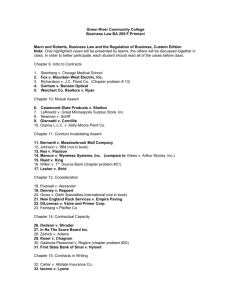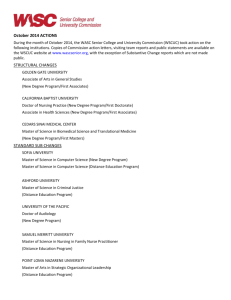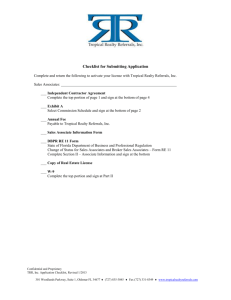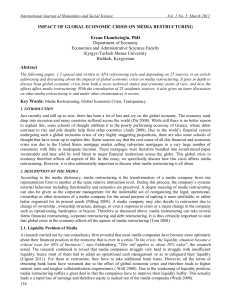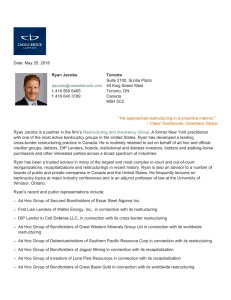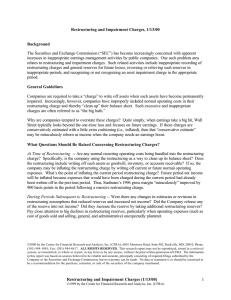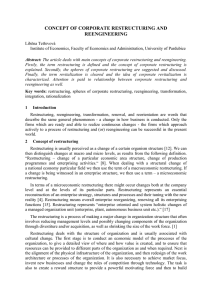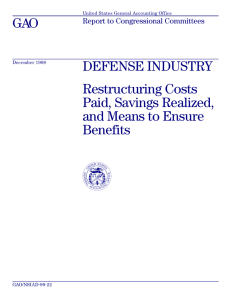6-Step Problem Solving Model: A Practical Overview
advertisement
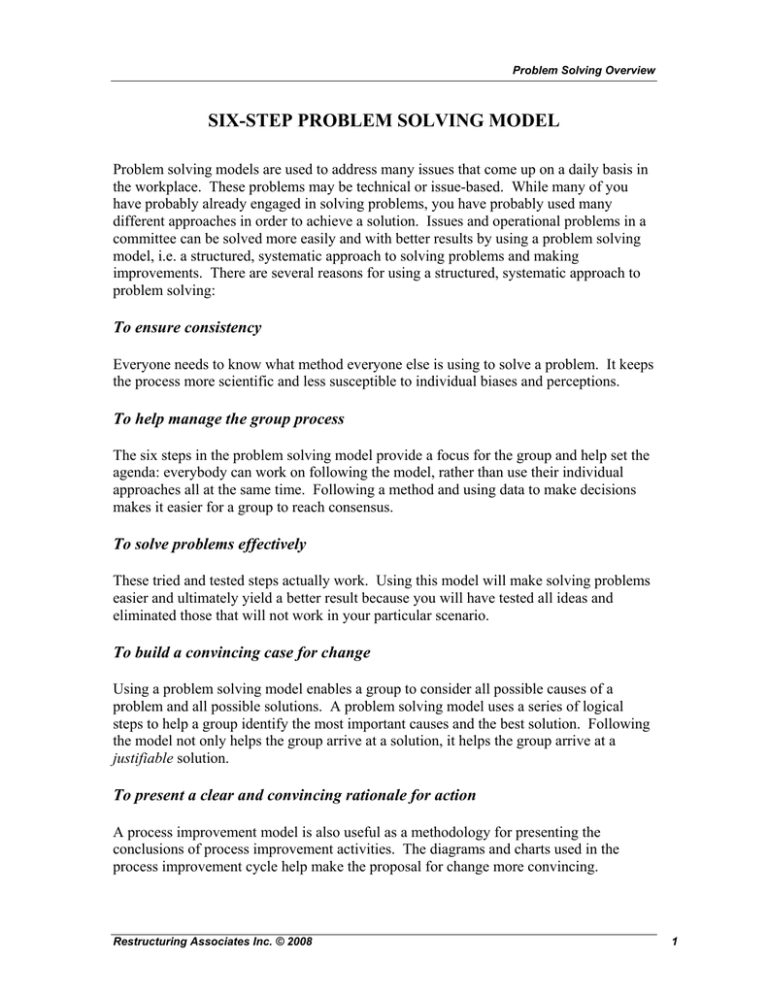
Problem Solving Overview SIX-STEP PROBLEM SOLVING MODEL Problem solving models are used to address many issues that come up on a daily basis in the workplace. These problems may be technical or issue-based. While many of you have probably already engaged in solving problems, you have probably used many different approaches in order to achieve a solution. Issues and operational problems in a committee can be solved more easily and with better results by using a problem solving model, i.e. a structured, systematic approach to solving problems and making improvements. There are several reasons for using a structured, systematic approach to problem solving: To ensure consistency Everyone needs to know what method everyone else is using to solve a problem. It keeps the process more scientific and less susceptible to individual biases and perceptions. To help manage the group process The six steps in the problem solving model provide a focus for the group and help set the agenda: everybody can work on following the model, rather than use their individual approaches all at the same time. Following a method and using data to make decisions makes it easier for a group to reach consensus. To solve problems effectively These tried and tested steps actually work. Using this model will make solving problems easier and ultimately yield a better result because you will have tested all ideas and eliminated those that will not work in your particular scenario. To build a convincing case for change Using a problem solving model enables a group to consider all possible causes of a problem and all possible solutions. A problem solving model uses a series of logical steps to help a group identify the most important causes and the best solution. Following the model not only helps the group arrive at a solution, it helps the group arrive at a justifiable solution. To present a clear and convincing rationale for action A process improvement model is also useful as a methodology for presenting the conclusions of process improvement activities. The diagrams and charts used in the process improvement cycle help make the proposal for change more convincing. Restructuring Associates Inc. © 2008 1 Problem Solving Overview A systematic approach to problem solving allows for: • decision making based on data, rather than hunches • determining root causes of problems, rather than reacting to superficial symptoms • devising permanent solutions, rather than relying on quick fixes Although problem solving models can be highly sophisticated and technical, the following model has just six simple steps. Despite its simplicity, this model is comprehensive enough to address all but the most technical problems. The simplicity of the model makes it easier for your group to remember when solving a problem. The Problem Solving Model 6. Evaluate the Outcome 1. Define the Problem 2. Determine the Root Cause(s) of the Problem 5. Implement the Solution 4. Select a Solution 3. Develop Alternative Solutions The steps in this sequence are arranged in a circle to emphasize the cyclical, continuous nature of the problem solving process. All six steps must be followed in the order shown above, beginning with the first step, “1. Identify the Problem.” Each step must be completed before the group proceeds clockwise to the next step. 2 Restructuring Associates, Inc. © 2008 Problem Solving Overview There are several important characteristics to this model: The steps are repeatable At any step in the process, your group may decide to go back and repeat an earlier step. For example, diagnosing a problem can often lead back to redefining the problem. The process is continuous Simply implementing a solution does not end the problem solving process. Evaluation of that solution may identify new aspects of the problem or new problems that need to be addressed, leading the group back to step one, where the new problem is identified. Although the steps all have distinct names, there is no clear demarcation between them. For example, “identifying” and “diagnosing” a problem are two steps that may frequently overlap. Let’s look at each of the steps a little more closely. Step One: Define the Problem The first step, identifying the problem, is a broad review of the current situation — a fitting together of information, like pieces of a puzzle. In this first stage, a group identifies and discusses the symptoms and scope of the problem. That is, it determines what “hurts,” the degree to which the symptoms are shared, and the urgency of relieving the symptoms. Groups use tools such as brainstorming, interviewing, and completing questionnaires to gather this information. As you go through this step, you will find yourselves raising, reviewing, and discarding statements of the problem as you sort out what are merely symptoms of the problem and then look behind those symptoms to make a tentative definition of the underlying problem. Step Two: Determine the Root Cause(s) of the Problem Once you recognize the symptoms and have tentatively defined the problem, your group can begin to collect information about the nature of the problem. At this step, you may use tools such as the Fishbone diagram, or Pareto analysis to help you organize this information and zero in on underlying causes of the problem. In this way, you determine the root causes of the problem. When you restate the problem, your definition will reflect the causes. Your efforts over the next two steps can thus be directed to finding solutions that address the roots of a documented problem, not merely its random symptoms. Restructuring Associates Inc. © 2008 3 Problem Solving Overview Step Three: Develop Alternative Solutions Once you have defined a problem, your “knee-jerk” reaction may be to jump toward a particular solution. However, creative problem solving requires you to explore a full range of viable solutions before reaching a conclusion. To assemble a variety of solutions from which to choose a final solution, you must: • generate as many potential solutions as possible • relate each solution to the causes of the problem • merge similar or related solutions At this stage, you are still not ready to select the best solution. You simply want to reduce redundancy, and eliminate any possibilities that don’t address the causes you identified earlier. Force field analysis is a good tool for preliminary screening of this solution field. Step Four: Select a Solution As a fourth step, evaluate each potential solution for its strengths and weaknesses. Selecting a solution entails searching for the most effective solution by applying two general criteria. An effective solution: • is technically feasible • is acceptable to those who will have to implement it Feasibility is determined by asking the following questions: Can it be implemented in a reasonable time? Can it be done within cost limits? Will it work reliably? Will it use staff and equipment efficiently? Is it flexible enough to adapt to changing conditions? Ask these questions when evaluating a solution’s acceptability: 4 Restructuring Associates, Inc. © 2008 Problem Solving Overview Do the implementers support the solution, perceiving it as worth their time and energy? Are the risks manageable? Will the solution benefit the persons affected by the problem? Will it benefit the organization? Selecting a solution requires you to choose one that will be effective – one that has sufficient technical quality to resolve the problem, and is acceptable to those who will implement it. Step Five: Implement the Solution Choosing a solution does not immediately solve a problem. Putting a solution into action may prove as difficult as deciding on one. The implementation stage requires action planning: What must be done? Who will do it? When will it be started? When will key milestones be completed? How will the necessary actions be carried out? Why are these actions a solution? Step Six: Evaluate the Outcome In simplest terms, evaluation is the monitoring that any project needs to ensure that milestones are met, costs are contained, and work is completed. Unfortunately, most groups neglect or short-change the evaluation step, and therefore do not get the continued results or performance they were hoping to achieve. Effective groups, however, plan additional feedback mechanisms to detect the need for midcourse corrections and to ensure that the problem is solved without creating new problems. Collecting data and reporting on what has been accomplished also keeps a group credible with its constituents. Finally, reflecting on its own processes and results keeps a group effective. It also brings the problem-solving process full circle, as reflecting on results helps a group identify its next step. Restructuring Associates Inc. © 2008 5 Problem Solving Overview Summary In JDCs, committee members will be responsible for analytical problem solving. As you work together to solve problems, keep the six-step model in mind. It will help to keep committee discussions on target. Remember that any member can remind the committee: Aren’t we trying to diagnose the problem at this stage? Why are we talking about solutions? This analytical problem solving model is also a reminder that a subcommittee has not finished — but just begun — its work when it decides on the best solution. Without the framework of the problem solving model, it is all too easy for groups to forget the followthrough and the planning that make the solution a reality. 6 Restructuring Associates, Inc. © 2008

